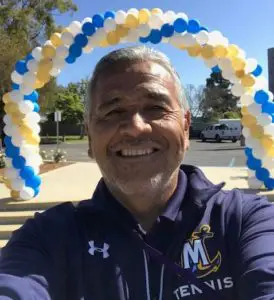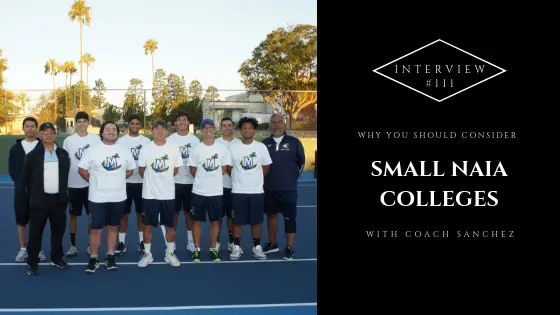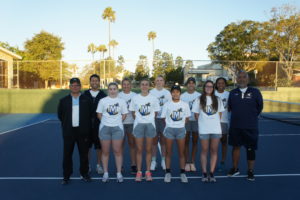Why You Should Consider Small NAIA Colleges with Coach Sanchez
I am excited to bring you this interview with NAIA Men’s and Women’s Tennis Coach Jamie Sanchez, of Marymount California University.
Coach Sanchez is a legend in the college tennis world. He has compiled numerous awards and recognition throughout his 40+ year career. We are fortunate Coach Sanchez has taken some time out of his busy schedule to give athletes and families incredible insights into the recruiting process and what to look for in a school.
Coach Sanchez is bringing tennis back to Marymount California University (Tennis was cut in 2006). This is a new adventure for Coach Sanchez, who built the Division 1 Loyola Marymount University Women’s Tennis team in 1975 and coached there for 40 years, including 21 as the men’s coach as well.
- The men’s inaugural match was January 26 and the women kick off February 1. Congratulations to all the players, coaches, and administrators who have worked so hard to bring Tennis back to to Marymount California University.
Without further ado,
Welcome to Interview #111.
Why you should consider first year and programs in a rebuilding process
How do you find players for a team that has not yet played a match?
Marymount California University virtually sits in a community that most people would say is one of the greatest tennis center of Southern California. One thing is for certain, it is a rich resource for a tennis program starting up.
I started by reaching out to the local high school coaches, Tennis Club teaching pros, local junior colleges and making them aware that Marymount California University would be starting a competitive men’s and women’s tennis program in Spring 2019. I placed an ad in the INSIDE Tennis Magazine giving my cell number and asking for players to reach out to me.
I have spent and will continue to spend my time meeting and talking to people about Marymount California University and it’s tennis program.
What would you tell prospective athletes are the benefits and challenges which await them at a first year program?
The benefits and the obstacles are mirror images of each other: an athlete joining a first year intercollegiate 4-year program would be making an immediate impact on the school, on the local community, on Southern California Tennis and on their individual tennis resume. This might have the gamut of wins and/or losses and everything would establish a healthy and successful intercollegiate program. This is an opportunity to step into an environment of competition that they will be able to say that they started. Everything accomplished would be a first for all of the areas mentioned above.
What are college coaches looking for in a potential recruit?
What are you looking for in a tennis player as you are on the recruiting trail? What is most important to you?
I am looking for players that want to improve. I am looking for players that have an upside to their game. The players that I recruit/invite to join this program will be those that still in the horizon of a better tennis game then they have now and have the passion and drive to go get it. These are players who look excited to be out on the court; who compete on every point won or lost; who compete on every point whether ahead or behind in the score. This shows an intrinsic quality that fuels their desire to have an approach for continuous improvement based on the idea that small, ongoing positive changes can reap major improvements.
Why consider NAIA colleges?
Marymount will compete primarily in the NAIA. Why do you think athletes should consider an NAIA college? What are the benefits of an NAIA school specifically?
The NAIA offers a great education and opportunity to play college sports with smaller class sizes. Consider class size, what you can afford financially, and your priority – athletics, education, or an equal combination of both.
The NAIA recruiting process for both freshmen and transfers is less cumbersome, with few restrictions on the contact between a student-athlete and a coach. More frequent communication allows the student to become more comfortable with the school and athletics staff.
Once you have started your college experience by enrolling and/or attending classes, representatives from another NAIA school cannot initiate contact with you. This no-contact policy applies even if you have not started classes yet, but have drawn equipment and begun organized practice.
Why consider a small school?
Marymount has 1500 students, a relatively small school. Why would you recommend looking at small schools?
Here are some of the pluses of choosing a small college:
- You get small classes. At a small school you’ll rarely be in large classes; in most cases your classes will have fewer than 20 students. The smaller class size will give you an opportunity to ask questions, participate in discussion, and have a teacher who actually knows who you are.
- Your teachers will be more committed to teaching. At many universities, teachers who seek tenure and promotion have to make research their No. 1 priority and teaching No. 2. At small colleges teaching is often the main criteria for advancement, teachers will put more effort into preparing their classes.
- Your work will be evaluated more carefully. In larger schools, teachers have many more papers and exams to grade, so they don’t have as much time to offer feedback and suggestions on individual pieces of work. At small schools, a teacher will have more time to read your work and offer specific comments. This is one of the best ways to learn and grow intellectually.
- You’ll have more opportunity for one-on-one contact with your professor. At small colleges, you will get to know your professors and they will get to know you as well.
- You will have more freedom in the curriculum. Smaller colleges are more flexible about requirements and give you an opportunity to construct programs that meet your individual interests.
- You get the feeling that you count. Large universities can be very alienating places. At most small colleges, you will feel that everyone cares about you and whether you learn anything.
What are the differences in the recruiting process for athletes looking at small schools?
Recruiting is the lifeblood of any college program, and coaches are always looking for student-athletes who will contribute to the team and the program’s culture. Coaches are not only looking for the most talented players – they want to find hard-working, mature kids who will do well in the classroom and will be solid teammates.
I don’t believe there is a big difference in the recruiting process for athletes looking at small schools. One of the most important elements that a recruit should be looking for is whether the question “is this a good fit!” being answered.
As an athlete is looking looking at a school and a program should be looking with these in mind:
- Is this program going to challenge me, both academically and on the court?
- Is this program emphasizing tennis through a developmental program?
- Can you see a clear vision of what your role would be, in joining this program?
Coaches communicate to the student-athletes why they should come to their schools! The student athlete should get a strong feeling of why they want to go a school they are interested in joining.
Steps to getting an athletic scholarship
Could you share, in whatever detail you are comfortable, what kind of athletic scholarships your team will have?
Once an athlete is interested in our school there are several steps to take regarding our scholarship offer:
- Need to apply to the University
- Once an athlete is accepted; they are evaluated academically and may receive an academic merit award.
- We (the tennis program) cover the academic merit award in our scholarship budget and combine additional athletic scholarship monies for a complete athletic scholarship offer.
- A student-athlete can be eligible for additional monies above and beyond the athletic scholarship. This would be done through applying for financial aid by filling out the FAFSA (Free Application for Federal Student Aid)
Currently our complete scholarship offers are approximately 30-50 % of the total cost of attending the University. Our total cost for an incoming student-athlete is approximately $50,000.00
The role of the parent
What is the role of the parent in the recruiting process?
The essential role is to provide their kids with guidance and help in the decision-making process. They are ultimately a partner and an assistant in this process of recruiting.
I would encourage a parent to take part in any college visits and after setting aside time for the student to take the initiative in asking questions and having a conversation with the coach, they should be a part of the discussion so that they can help lay out all the facts when the time comes to look over the pros and cons. This helps to guarantee that decisions are made with a little more information leading to a feeling that the program and school is a good fit.
Common mistakes you don’t want to make
What are a few of the most common mistakes that prospective-student athletes make in the college recruiting process?
Ask enough questions! Be honest and transparent. Remember the recruiting process is about both parties learning as much as possible about each other and then deciding if it is a good fit.
Get to know the coach! It is about making sure your decision is based on what is best for you as an individual rather than what is best for the school or program.
You have had a long coaching career that will be important as you take on the task of building a tennis program from scratch. Can you share a creed, quote or philosophy you will instill into your athletes that will assist you in building a great culture quickly?
It is to create a culture of success that has an attitude:
-Where your vision of what you want to accomplish is through effort
-Doing what you are doing at the moment to the best of your ability
-Make every day an opportunity to grow and improve
-Use mistakes as an opportunity to learn and make improvements and adjustments to improve
Bonus Question: Is there anything important that you would like to share directly with high school athletes or tennis players in particular as they navigate the recruiting process?
Be yourself! Share the real you and be as open and willing as you can be.
To see Coach Jamie Sanchez’s full bio, click here.
Next, check out: NAIA Athletic Scholarships
LIKE WHAT YOU READ?
Please take a moment to share this on social media to benefit other prospective college athletes, by clicking on the “sharing is caring” buttons below.
Thanks,
Bryan
P.S. Come join our Facebook group, The Recruiting Code. This is the place to be for parents and coaches to talk about college recruiting. Come learn from each other, share stories and get information that will help your child become a college athlete.



